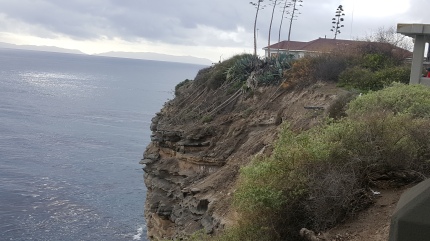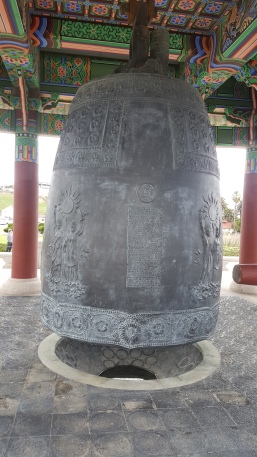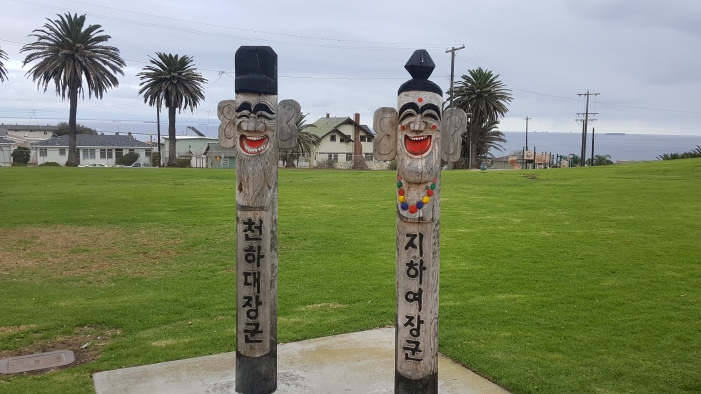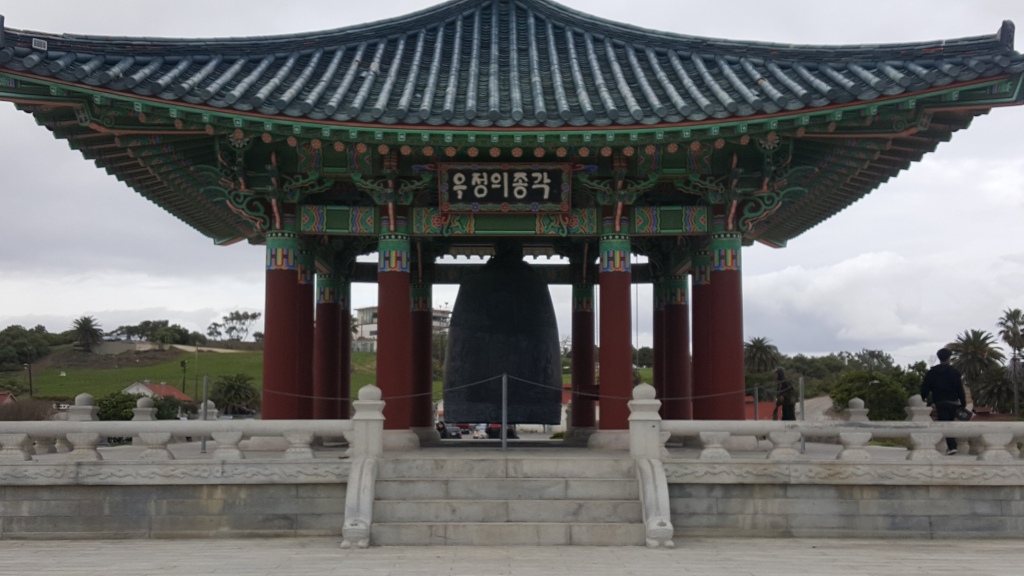Part of the reason I started this blog was to explore the weirder, out-of-the-way attractions that require more than a quick drive down the highway. Though with work and daily travel I find myself not always up for a five-mile excursion through tall grass and rocky shores. Sometimes, I find myself just wanting to enjoy the a good view and a calm breeze.
The Korean Bell of Friendship is an attraction that satisfies both of those needs. It is located in Sunken City, San Pedro — a quiet coastal town that can be reached with the aforementioned trip down the highway. Parking is ample, and the Bell is easy to spot; A welcome change.
Standing along the rocky coast, you can see how endless the edge of California can seem. It was cold and rainy the day we visited, something that is becoming normal here in Southern California. You hear claims that the drought has ended often now. With how often the weather has been dreary, it’s hard to argue. The light rain and drifting fog masks the southern island of Catalina, the landmass famous for their wine venues. It looks like the island out of Jurassic Park rather than a place to sip a Cabernet.

You can see the island far in the distance.
On top of a small hill on your side of the pond, surrounded by a chain-link fence and a well-kept lawn is a forty-one-year-old gift from a nation just over the Pacific ocean. One that stands for cooperation and peace between two cultures. A large wooden pavilion built to celebrate the United States’s birthday of over 200 years as well as honor those who gave their life on both sides of the Korean War.
The bell and the housing structure are a colossal feat of craftsmanship. It weighs seventeen tons, stands twelve feet tall, and has a diameter of seven and a half feet. It is comparable in size to a Fiat. The other important historical American bell, the Liberty Bell, only sits at three feet and is barely over a ton. It looks practically hand-sized sitting next to the West Coast behemoth.
Its heaviness serves a purpose rather than simply a bragging point. Comprised of gold, nickel, lead, and phosphorus, it generates an earthier resonance when struck than your traditional church bell. The phosphorous is what gives it a unique coloring, a chalky grey. On the bell, you can spot four pairs of figures. Always accompanying the Korean spirit is the Goddess of Liberty, proudly representing America. Each soul is carrying a different item that accounts for a quality of Korean culture: a branch of Korea’s national flower, the Rose of Sharon, a laurel branch, a symbol of victory, and finally a dove of peace.

Few areas of the pavilion were spared from the attention from the thirty craftsmen who came over from Korea forty years ago.. The original design of this bell came from the Bronze Bell of King Seongdeok; a Korean National Treasure crafted in 771 A.D. There is no clapper for this bell— instead, they opt for an old wooden log that gently taps the bell on four separate occasions: New Year’s Eve, July 4th, Korean Independence Day (August 14th), and every September during Constitution week.
The color of the housing is the most memorable aspect of the Korean Bell of Friendship. Weather-worn and diluted, yet teeming with inspiration and light are a mix of colors and designs not typically found in the sullen coastal town. The style of coloring used is called Dancheong and comes from a well-honored tradition from Korea. The artists, or dancheongjang, rely on five essential colors to do most of the heavy lifting: blue, white, red, black, and yellow. Which colors the artist uses depends entirely on the recipient, with particular colors representing social status and political or military rank.
On the side of the hill that the bell spends its days, there is a unique pair of concrete structures. One of them looks like a bunker overgrown with lush greens, the other a circular foundation. My initial guess was that this was something of military purpose. To my surprise, that guess was an underestimation. The entire area used to be a fortification to prevent a Japanese invasion after the second World War. Obviously, the artillery and anti-sea craft weaponry have long been removed. Nowadays, people use this area to peacefully eat their lunch and watch the ocean meet the stony coast.
There were a few areas on the coast that I would like to come back and visit. The Sunken Coast itself is exactly as a name implies: a town that rests on a degenerating chunk of earth. One earthquake of regular portions and people could lose their homes into the Pacific Ocean. I would hope I have a chance to see it once more before the inevitable happens.

In the meantime, stay happy, party people.
